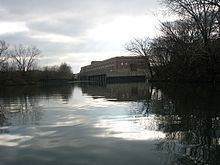GNIS ID 1826468 Country United States of America | Length 3 km | |
 | ||
Similar Union Stock Yards, Chicago Sanitary and Ship, Calumet River, Union Stock Yard Gate, North Shore Channel | ||
Bubbly creek the weirdest river in chicago
Bubbly Creek is the nickname given to the South Fork of the Chicago River's South Branch, which runs entirely within the city of Chicago, Illinois, U.S. It marks the boundary between the Bridgeport and McKinley Park community areas of the city. The creek derives its name from the gases bubbling out of the riverbed from the decomposition of blood and entrails dumped into the river in the early 20th century by the local meatpacking businesses surrounding the Union Stock Yards directly south of the creek's endpoint at Pershing Road. It was brought to notoriety by Upton Sinclair in his exposé on the American meat packing industry entitled The Jungle.
Contents
- Bubbly creek the weirdest river in chicago
- Map of South Fork Chicago River Chicago IL USA
- History
- Present situation
- References
Map of South Fork Chicago River, Chicago, IL, USA
History
The area surrounding Bubbly Creek was originally a wetland; during the 19th century, channels were dredged to increase the rate of flow into the Chicago River and dry out the area to increase the amount of habitable land in the fast-growing city. The South Fork became an open sewer for the local stockyards, especially the Union Stock Yards. Meatpackers dumped waste, such as blood and entrails, into the nearest river. The creek received so much blood and offal that it began to bubble methane and hydrogen sulfide gas from the products of decomposition.
In 1906, author Upton Sinclair wrote The Jungle, an unflattering portrait of America's meat packing industry. In it, he reported on the state of Bubbly Creek, writing that:
Present situation
Two heavily polluted streams that joined to create the South Fork were later filled in, but their courses can still be seen today in the configuration of streets and railroad tracks in the area.
The area has been increasingly occupied by residential development such as Bridgeport Village; a program to oxygenate the creek by continuously injecting compressed air into the water has met with limited success; the creek's odor is much reduced, and some fish and vegetation have returned in recent decades. Areas near the creek have been designated for recreational uses including parks, and developers and the city agreed on a 60-foot (18 m) setback to allow for remediation. However, during heavy rains, millions of gallons of wastewater continue to be dumped into the stagnant creek by the Metropolitan Water Reclamation District of Greater Chicago.
As of 2007, the City of Chicago and the Army Corps of Engineers were considering a $2.65 million feasibility study to look at restoration options, which would have implications for the remainder of the Chicago River system due to the unusual challenges of Bubbly Creek. The creek's waters are largely stagnant, having little gravitational flow; the study will look into possibilities, including a meandering stream amid a wetland, to restore an oxygenated system. The actual renovation project is expected to cost $15.4 million. In 2015, the project was stalled, due to contamination discovered in the creek's sediments.
